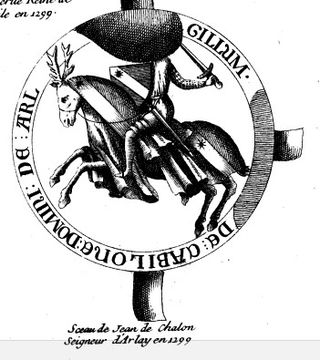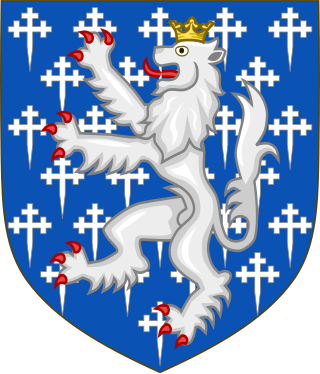
Prince of Orange is a title associated with the sovereign Principality of Orange, in what is now southern France and subsequently held by the stadtholders of, and then the heirs apparent of, the Netherlands.

This is a list of the Lords, Barons and Marquisses of Baux.
The House of Baux is a French noble family from the south of France. It was one of the richest and most powerful families of medieval Provence, known as the 'Race d’Aiglon'. They were independent lords as castellans of Les Baux and Arles and wielded very considerable authority at the local level. They held important fiefs and vast lands, including the principality of Orange.

The Anscarids or the House of Ivrea were a medieval dynasty of Burgundian and Frankish origin which rose to prominence in Northern Italy in the tenth century, even briefly holding the Italian throne. The main branch ruled the County of Burgundy from the eleventh to fourteenth centuries and it was one of their members who first declared himself a count palatine. The cadet Castilian branch of Ivrea ruled the Kingdom of Galicia from 1111 and the Kingdoms of Castile and León from 1126 until 1369. The Spanish House of Trastámara, which ruled in Castile, Aragon, Naples, and Navarre at various points between the late 14th and early 16th centuries, was an illegitimate cadet branch of that family.
John IV was a Count of Armagnac, Fézensac, and Rodez from 1418 to 1450. He was involved in the intrigues related to the Hundred Years' War and in conflicts against the King of France.

Hugh I of Chalon-Arlay (1288–1322) was lord of Arlay and of Vitteaux, and belonged to the house of Chalon-Arlay. He was the son of lord John I of Chalon-Arlay and his first wife Marguerite of Burgundy, and his grandfather John, Count of Chalon was count-regent from the death of Otto III, count of Burgundy onwards. On 13 February 1302 Hugh I married Béatrice de La Tour-du-Pin (1275–1347). They had one child
This page is a list of the lords of Chalon-Arlay and the principality of Orange. The lords of Chalons and Arlay were a cadet branch of the ruling house of the county of Burgundy, the Anscarids or House of Ivrea.

Jean I of Chalon-Arlay (1258–1315) was a French nobleman. He was the son of Jean, Count of Chalon and Laure de Commercy, a couple who had thirty castles built on the Jurassian part of the county of Burgundy around their new seigneurie of Salins, including the Château d'Arlay. He was Seigneur of Arlay (1266–1315) and Viscount of Besançon (1295–1315).

John II, lord of Chalon-Arlay was a member of the House of Chalon-Arlay. He succeeded his father Hugh I lord of Arlay to this title, and was himself succeeded by his son, Hugh II lord of Arlay.

Hugh II of Chalon-Arlay (1334–1388) was the son and successor as lord of Arlay to John II. His mother was Marguerite of Mello.

John IV of Chalon-Arlay or John of Chalon was a prince of Orange and lord of Arlay. He played an important role in the Mad War, a series of conflicts in which aristocrats sought to resist the expansion and centralisation of power under the French monarch.

William VII of Chalon was a prince of Orange and lord of Arlay. He was the son of Louis II lord of Arlay and his wife Johanna of Montfaucon

Louis II of Chalon-Arlay, nicknamed the Good, was Lord of Arlay and Arguel Prince of Orange. He was the son of John III of Chalon-Arlay and his wife, Mary of Baux-Orange, and the father of William VII of Chalon-Arlay.

The House of Chalon-Arlay was a French noble house, a cadet branch of the House of Ivrea. The founder of the house is John I of Chalon-Arlay, fifth son of John, Count of Chalon. When John III lord of Arlay married to Mary de Baux, princess of Orange, the House acquired the principality of Orange.

Margaret, Countess of Vertus, was a French vassal, ruling Countess of Vertus and Etampes 1420–1466. She was the daughter of Louis I, Duke of Orléans, and Valentina Visconti.

Raoul II/III of Clermont-Nesle was Seigneur (Lord) of Nesle in Picardy (de), Viscount of Châteaudun (de), Grand Chamberlain of France and Constable of France.

Anthony I, Count of Ligny (1450–1519) was the youngest son of Louis de Luxembourg, Count of Saint-Pol and his wife, Jeanne de Bar, Countess of Marle and Soissons. In 1482, he inherited the County of Brienne from his brother Peter II, Count of Saint-Pol. After the death of Charles of Bourbon in 1510, Anthony inherited the County of Ligny, which thereby fell back to the House of Luxembourg.

Louis I of Chalon-Arlay (1337–1366) was the second son of John II lord of Arlay and Margaret of Male.
Mary of Baux-Orange was suo jure Princess of Orange. She was the last holder of this title from the House of Baux.

Simon IV, Count of Saarbrücken, Simon of Saarbrücken-Commercy. He was the Count of Saarbrücken (de) and Seigneur (lord) of Commercy (fr).










